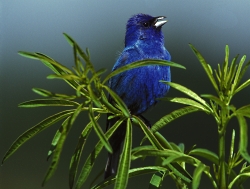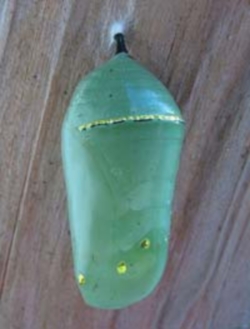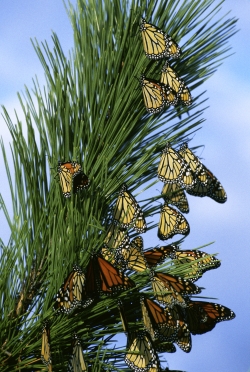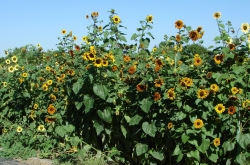
Courtesy Wikimedia,
Bruce Marlin, Photographer
Licensed under
Creative Commons Attribution-
Share Alike 2.5 Generic license
 Firefly viewing spot
Firefly viewing spot
Heritage Park, Nibley, UT
2456 S 800 W
Access 800 W from either 2600 S
(from Hwys 165 or 89)
OR 2200 S (Hwy 89 only)
41° 41′ 23″ N 111° 51′ 17″ W
Courtesy Google Earth, Imagery Date 8/11/2011
Hi, I’m Holly Strand.
One of my greatest delights during childhood was to visit my grandmother in North Carolina. For around her farmhouse I could spend endless hours chasing and catching fireflies–we called them lightening bugs back then. As an adult, I am still captivated by the dancing lights that animate the muggy darkness, often with a background chorus of crickets and cicadas.
Flashing in fireflies evolved as a way to identify a mate. The male flashes his invitation while patrolling the local air space. If a female is impressed, she responds, either from the ground or at some perch in a shrub or on tall grass. Different species emit different flash patterns to avoid interspecific mix-ups.
Fireflies are very common in the moister, eastern half of the US. Look for them near ponds, streams, wet meadows and marshes. Many popular science sources will assert that fireflies don’t occur in the arid west. Or they will say that fireflies in the west don’t flash. For while the larvae of all firefly species glow, the adult forms of some species don’t flash. And those non-flashing forms are the species which are documented online and in collections for Utah and surrounding states.
Until recently I felt sorry that Utah kids don’t get to experience these magical bioluminescent displays. But on Monday night just before 10 PM, my family and I stood at the end of the sidewalk behind the soccer fields in Nibley’s Heritage Park. As the sky darkened, tiny amber lights began to wink on and off. An entire field of twinkling lights lay before us. I had to pinch myself to make sure I wasn’t dreaming.
I asked around and discovered that –in the last 10 years or so–there have been several sightings of flashing fireflies here in Utah. In 2002, biologist Jim Cane discovered some in River Heights. Utah State University’s Insect Collection features a 2007 specimen from Heber Valley. In recent years, additional sightings have been reported in Escalante, the Uinta, Spanish Fork and now Nibley.
We don’t know why Utahns are now able to enjoy these insect light displays. Have the flashing fireflies always been here and we just didn’t notice them? Did we notice them, but didn’t document it publicly? Or is the range of this particular species expanding? And if so, why?
To see the Nibley fireflies check our website www.wildaboututah.org. We’ve posted a map. And if you have seen flashing fireflies now or in the recent past here in Utah, let us know and we’ll post it on our website for others who might be nearby.
In general, firefly populations are declining around the world, and they are obviously still rare here. So if you run across them, treat them with respect!
Thanks to Utah State University entomologists Charles Hawkins, Ted Evans and Jim Cane for sharing their firefly expertise.
For Wild About Utah, I’m Holly Strand.
Credits:
Image: Courtesy Wikimedia, Bruce Marlin, Photographer
Map/Satellite Image: Courtesy Google Earth
Theme music: Composed by Don Anderson and performed by Leaping Lulu, https://leapinglulu.com/
Text: Holly Strand
Reported Sightings:
22 June 2013
I just read the article about fireflies and want to say I’ve seen them in Mill Creek Canyon, just out of Moab (not Mill Canyon, which is north of town). I’m familiar with them from being in Missouri as a kid on vacation to see relatives.
Thanks for a great website! CM
24 June 2017
Today while waiting for local city fire works we saw a lighting bug or two. We are in West Haven.
Sources & Additional Reading
Buschman, Lawrent L., Biology of the Firefly Pyractomena lucifera (Coleoptera: Lampyridae). The Florida Entomologist. 1984. Vol. 67(4):529. DOI: 10.2307/3494462 https://www.jstor.org/stable/3494462?origin=crossref&seq=5
Lloyd, James E., 1964. Notes on Flash Communication in the Firefly Pyractomena dispersa (Coleoptera: Lampyridae) Annals of the Entomological Society of America, Volume 57, Number 2, March 1964 , pp. 260-261. (James Lloyd is a leading authority on fireflies. He retired from academic duty at the University of FL, but here is a web page with some of his wisdom and musings. https://entnemdept.ufl.edu/lloyd/firefly/
(Boston) Museum of Science Firefly Watch
Volunteers help citizen scientists track firefly occurrences.
https://legacy.mos.org/fireflywatch/
https://www.massaudubon.org/programs-events/community-science/firefly-watch/view-explore-data
National Geographic. Firefly (Lightning Bug) Lampyridae
https://animals.nationalgeographic.com/animals/bugs/firefly/
Phys.org news service. Jun 26, 2012. Romancing the firefly: New insights into what goes on when the lights go off. https://phys.org/news/2012-06-romancing-firefly-insights.html#inlRlv
Stanger-Hall, Kathrin F., James E. Lloyd, David M. Hillis. 2007. Phylogeny of North American fireflies (Coleoptera: Lampyridae): Implications for the evolution of light signals. In Molecular Phylogenetics and Evolution 45 (2007) 33-49. http://www.bio-nica.info/biblioteca/stangerhall2007fireflies.pdf
Utah State University Insect Collection has over 117 cabinets housing approximately two million pinned insects and 35,000 microscope slides. Location: Room 240, Biology and Natural Resources Bldg.; Telephone: 435-797-0358
https://www.usu.edu/biology/research/insect-holdings/









